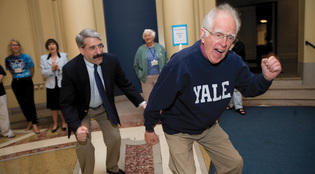 loading
loading
NotebookGreek revivalThe tradition of the Long Cheer. If you walked through the Woolsey Hall Rotunda on May 31, on Saturday of the first reunion weekend, just after the president’s speech, you might have encountered an event that was not on the reunion schedule. There, in front of a video crew and whoever happened to pass by, two full-grown men were jerking their arms to and fro, bending down, leaping up, and shouting a peculiar incantation:
 Julie BrownYale College dean Peter Salovey ’86PhD (left) takes instruction from former Yale cheerleader Frank Gibson ’49 in performing the Long Cheer. The nearly forgotten Yale tradition dates back to the 1880s; its words date back to ancient Greece. View full imageThose of you who are Yale College alumni over the age of, say, 70, already know what I’m talking about. The liturgical dancers were performing the Long Cheer, a Yale ritual that was born in the 1880s and survived until—well, we’re not sure, but probably the 1960s, when so many vestiges of Old Yale bit the dust. The two men were teacher and student: Frank Gibson ’49, a former Yale cheerleader, was showing Yale College dean Peter Salovey ’86PhD the fine points of a cheer that was once shouted by thousands at the Yale Bowl. Robert H. O’Connor ’45W, ’48E, would like to see that happen again. As football manager in 1947, O’Connor was responsible for appointing the head cheerleader, and he chose Gibson. Like most Yalies of his time, O’Connor knew the Long Cheer, but he never really knew it until the day he was summoned to the office of then-university secretary Carl Lohmann ’09, who complained to him that the student body had forgotten the proper way to do the Long Cheer. “He came out from behind his desk and showed me,” recalls O’Connor. Gibson himself remembers learning the intricacies of the cheer, from Jonathan Edwards College master Robert Dudley French, not long after he arrived as a freshman in 1944. (Click here to read Gibson’s story of how it happened.) As students of ancient Greek will know, the seemingly nonsensical words of the cheer have their origins in Aristophanes’ comedy The Frogs, written in about 405 BCE. “Brek-ek-ek-ex, ko-ax, ko-ax” is the sound a chorus of frogs makes as Charon ferries Dionysus across a lake in Hades. (If you don’t think frogs sound like that, by the way, try listening to Pelophylax ridibundus, a marsh frog common in Greece.) In January 1884, a group of sophomores studying their Greek got a little punchy and decided the frog chorus would make a great cheer. To the “Brek-ek-ek-ex, ko-ax, ko-ax” they added a couple of Charon’s lines: “o-op” (“avast”) and “parabalou” (“lay to”). A few months later, they introduced the cheer during a low point at a baseball game. It spurred the Bulldogs to victory and became a long-lasting part of the repertoire, acquiring a coda of staccato “Yale”s and “Rah”s somewhere along the way. (Click here for Judith Ann Schiff’s 1998 column about the cheer’s origin, and here to read the letters we got in response.) It was O’Connor who organized the Woolsey Hall lesson (which was to be a private one until the Yale Alumni Magazine heard about it and brought cameras). He had seen a photo of Salovey directing the Yale band at a hockey game, he says, and thought, "If he can do that, he can lead the Long Cheer.” O’Connor’s dream is that Salovey will lead a renaissance of the cheer among his student charges. If you want to learn the Long Cheer, watch our video as often as needed. The dean may need to consult it himself a few times between now and football season.
|
|
1 comment
-

Jonathan David Frechette , 10:03am November 22 2014 |  Flag as inappropriate
Flag as inappropriate
The comment period has expired.I doubt taking incantations lightly is prudent. In the sixties Americans discovered for the first time that American wars were unholy. The body itself is the Holy Land. If we make shapes and sounds with our bodies we can call upon any entity we wish.I wish to serve our Creator as a King and a Priest of Love and Compassion. I am a Ubuntu coordinator for CT. I graduated from Yale in 1979. I answer only to God, not to Country or Yale. Bless us all <3 Johnny F. class of 79